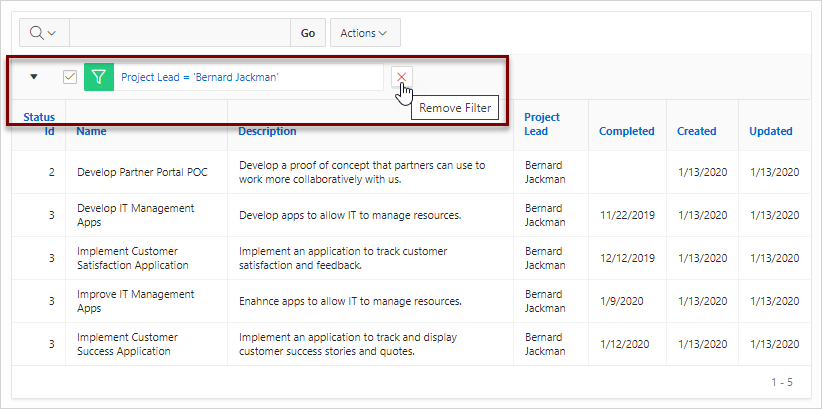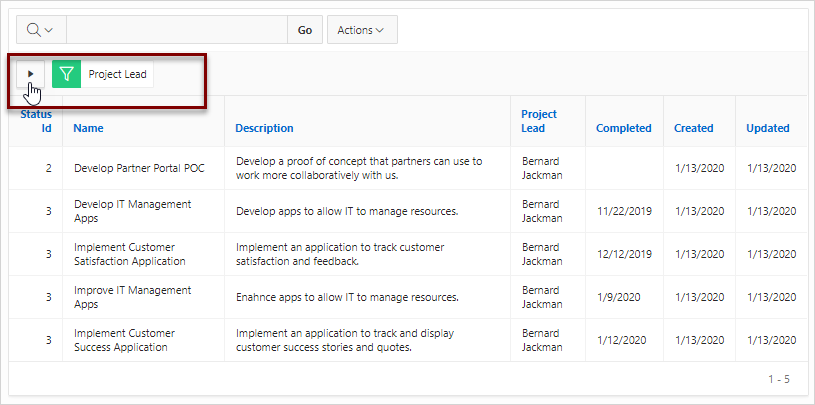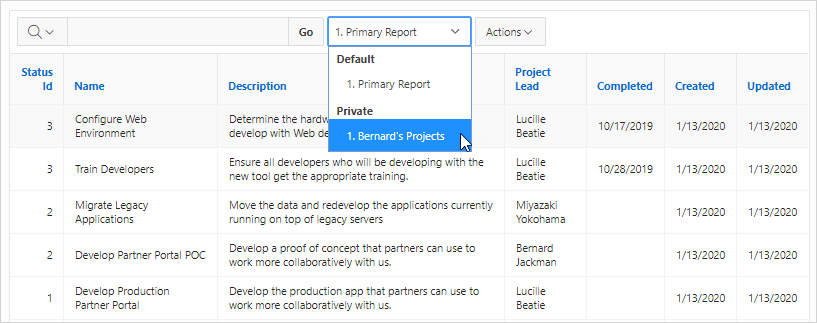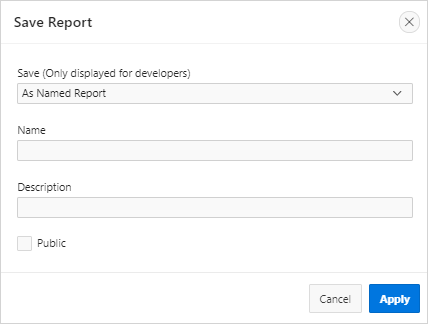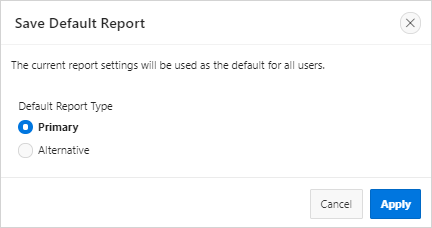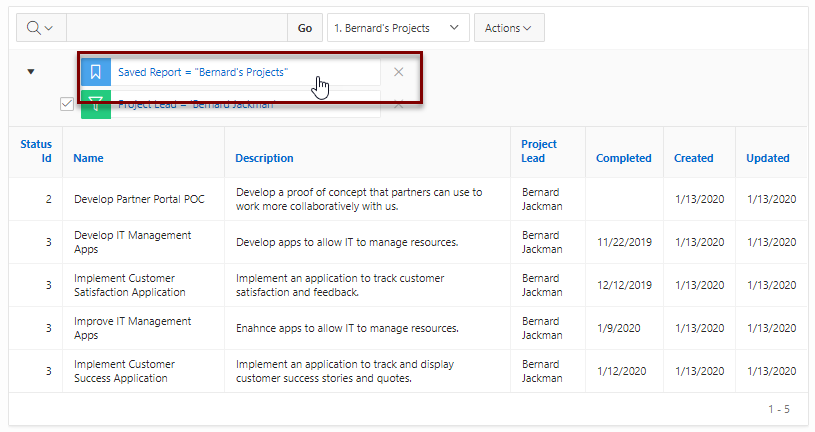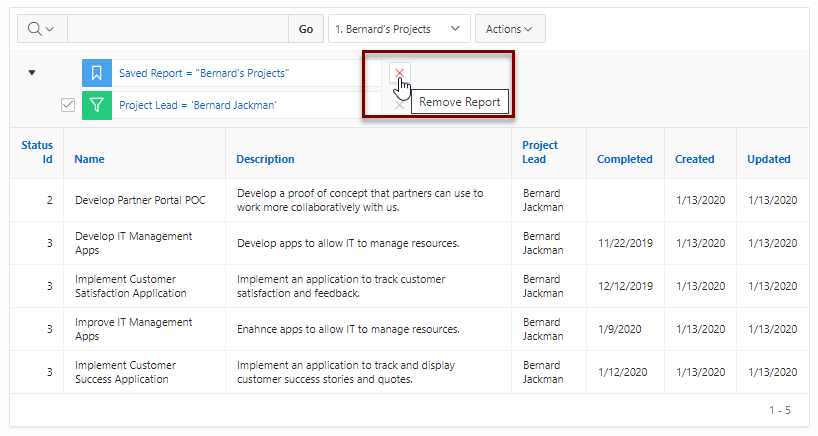8.9.8 Customizing Interactive Reports in a Running Application
When running an application, end users and developers can alter the layout of interactive reports data by choosing the columns they are interested in, applying filters, highlighting, and sorting. They can also define breaks, aggregations, charts, group bys, and add their own computations.
- About the Search Bar
Learn about the interactive report search bar. - About the Actions Menu
Learn about the interactive report Actions menu. - Using Interactive Report Filters
Learn about using interactive report filters. - Saving Interactive Reports
Learn about saving private and public interactive reports.
Parent topic: Managing Interactive Reports
8.9.8.1 About the Search Bar
Learn about the interactive report search bar.
A search bar displays at the top of every interactive report and may include the following features:
- Select Columns to Search - This icon resembles a magnifying glass. Click this icon to narrow your search to specific columns. To search all columns, select All Columns.
- Text Area - Enter case insensitive search criteria (wildcard characters are implied) and click Go.
- Go Button - Executes a search.
- Reports - Displays alternate default and saved private, or public reports. See Saving Interactive Reports.
- View Icons - Switches between an View Icon, View Report and View Detail of the default report (if enabled). May also include Chart and Group By View (if defined).
- Actions menu - Use the Actions menu to customize an interactive report. See About the Actions Menu.
Parent topic: Customizing Interactive Reports in a Running Application
8.9.8.2 About the Actions Menu
Learn about the interactive report Actions menu.
Note:
The structure of the interactive report Actions menu has changed to be consistent with interactive grids. To alter an interactive report Actions menu to use the previous (or legacy) structure, go to Shared Components, Component Settings, and configure the Interactive Report component. See Configuring Interactive Report Action Menu Structure.
The Actions menu appears to the right of the Go button on the Search bar. End users use the Actions menu to customize an interactive report.
See Also:
Customizing an Interactive Report Using the Actions Menu in Oracle APEX End User’s Guide
Parent topic: Customizing Interactive Reports in a Running Application
8.9.8.3 Using Interactive Report Filters
Learn about using interactive report filters.
When you customize an interactive report, a filter displays between the search bar
and the report. The following illustration shows an interactive report with one
filter, Project lead = 'Bernard Jackman' .
Other keys features of interactive report filters include:
-
Enable/Disable - To enable and disable a filter, select and deselect the checkbox to the left of the filter name.
-
Filter Edit - To edit a filter, click the filter name.
-
Remove Filter - To remove a filter, select the Remove Filter icon to the right of the filter name.
By default, multiple filters display horizontally stacked on top of one another. To minimize the amount of information that displays and hide filter details, click the arrow to the left of the filter name. The following illustration shows the same report with the filter details hidden.
Parent topic: Customizing Interactive Reports in a Running Application
8.9.8.4 Saving Interactive Reports
Learn about saving private and public interactive reports.
All users can save a private or public interactive report. However, only the user who creates a private report can view, save, rename, or delete it. Developers have additional save capabilities in that they can save the report that initially displays, called the Primary Default, or create an Alternative Default report.
- About the User Type and Available Save Options
Learn how end users and developers can save interactive reports. - About Configuration Dependencies When Saving Interactive Reports
Developers control how users can save an interactive report by editing report Attributes. - Saving a Public or Private Interactive Report
End users can save public or private interactive reports. - Saving a Default Interactive Report
Developers can save primary and alternative interactive reports. - Renaming a Public or Private Interactive Report
Rename a public or private interactive report. - Deleting a Public or Private Interactive Report
Delete a public or private interactive report - About Exporting Interactive Reports
Learn about exporting interactive reports.
See Also:
Managing Saved Interactive Reports in Oracle APEX Administration Guide
Parent topic: Customizing Interactive Reports in a Running Application
8.9.8.4.1 About the User Type and Available Save Options
Learn how end users and developers can save interactive reports.
An end user can save an interactive report in two ways:
-
Public Report (End user and developer). This report is viewable by all users. However, only the user who creates a public report can save, rename, or delete it. Although all users can view a public report, they can only save it under a new report name.
-
Private Report (End user and developer). Only the user who creates the private report can view, save, rename, or delete it.
A developer can additionally save an interactive report in the following ways:
-
Primary Default (Developer only). The Primary Default is the report that initially displays. Primary Default reports cannot be renamed or deleted.
-
Alternative Report (Developer only). Enables developers to create multiple report layouts. Only developers can save, rename, or delete an Alternative Report.
The following illustration shows the Reports list on the Search bar of an interactive report.
This example shows two reports:
-
Default - Primary Report. This is the initial report created by the application developer. Default, Primary reports cannot be renamed or deleted.
-
Private - 1. Bernard's Projects. This is a Private report. Only the user who creates a private report can view, save, rename, or delete it.
Tip:
You can view saved report activity from the Workspace Administration page. On the Workspace home page, click the Administration menu and then select Administration, Monitor Activity, and then under Page Views select By Interactive Report.
Parent topic: Saving Interactive Reports
8.9.8.4.2 About Configuration Dependencies When Saving Interactive Reports
Developers control how users can save an interactive report by editing report Attributes.
To fully enable users to save private reports, a developer must:
- Define an authentication scheme for the current application.
- Edit the following report Attributes:
- Search Bar, Reports Select List — Set this attribute to On to include a Reports select list in the Search bar.
- Actions Menu, Save Report — Set this attribute to On to enable end users to save their current report definition as a Private report.
- Actions Menu, Save Public Report — Set this attribute to On to enable end users to save their current report definition as a Public report.
- Actions Menu, Save Public Report Authorization — Select an authorization scheme to restrict who can save public report definitions. To enable an end user to save a public report, this authorization scheme must evaluate to TRUE. If no authorization scheme is provided then reports may be saved by any user.
8.9.8.4.3 Saving a Public or Private Interactive Report
End users can save public or private interactive reports.
End users can save an interactive report and classify it as being either public or private. Public reports can be viewed by all users. Private reports can only be viewed by the user who saves the report.
Tip:
To save a public report, the developer must edit the report Attributes. In the Property Editor, locate Actions Menu and set Save Public Report to On. Developers can also apply an authorization scheme to enable or disable Save Public Report. See About Configuration Dependencies When Saving Interactive Reports.
To save a public or private interactive report:
- Go to the page containing the interactive report you want to save.
- Customize the report (for example, hide columns, add filters, and so on).
-
Click the Actions menu and select Report and then Save Report.
The Save Report dialog appears.
- For end users, the following Save Report dialog appears.
In Save Report:
- Name - Enter a name for the report.
- Description - Enter an optional description.
- Public - Select this option to make the report viewable to all users. Deselect this option to make the report private.
- Click Apply.
-
For developers, the following Save Report dialog appears.
In Save Report:
- Save - Select As Named Report.
- Name - Enter a name for the report.
- Description - Enter an optional description.
- Public- Select this option to make the report viewable to all users. Deselect this option to make the report private.
Tip:
The Public checkbox only displays if you have enabled the Save Public Report report attribute.
- Click Apply.
Parent topic: Saving Interactive Reports
8.9.8.4.4 Saving a Default Interactive Report
Developers can save primary and alternative interactive reports.
Developers can save two types of default interactive report: primary and alternative. Both reports display on the Report list on the search bar. However, primary default reports cannot be renamed or deleted.
To save a default interactive report:
Parent topic: Saving Interactive Reports
8.9.8.4.5 Renaming a Public or Private Interactive Report
Rename a public or private interactive report.
To rename a public or private interactive report:
Parent topic: Saving Interactive Reports
8.9.8.4.6 Deleting a Public or Private Interactive Report
Delete a public or private interactive report
To delete a public or private interactive report:
Parent topic: Saving Interactive Reports
8.9.8.4.7 About Exporting Interactive Reports
Learn about exporting interactive reports.
When you export an application, the Primary Default, Alternative Default, and public reports are included by default. Configure the Export Public Reports and Export Private Reports attributes to control the type of reports to include in your export.
See Also:
Parent topic: Saving Interactive Reports


